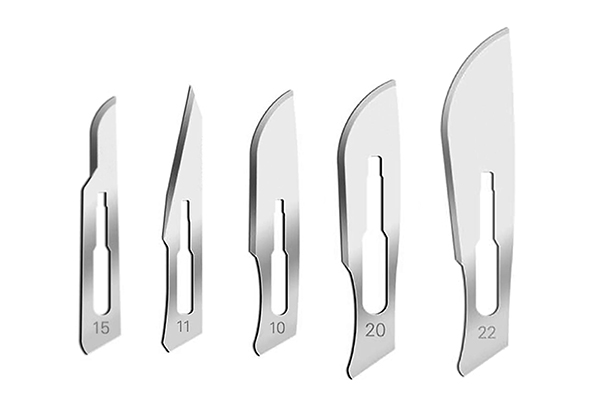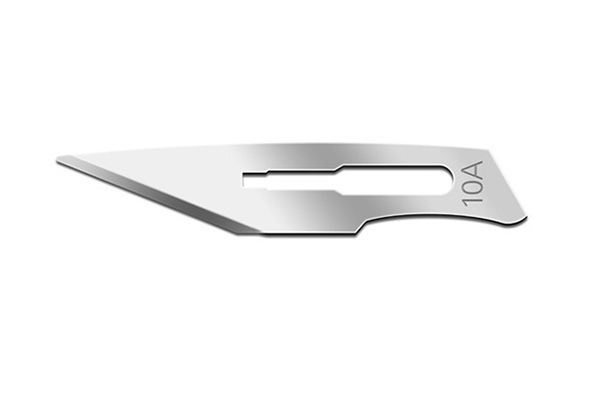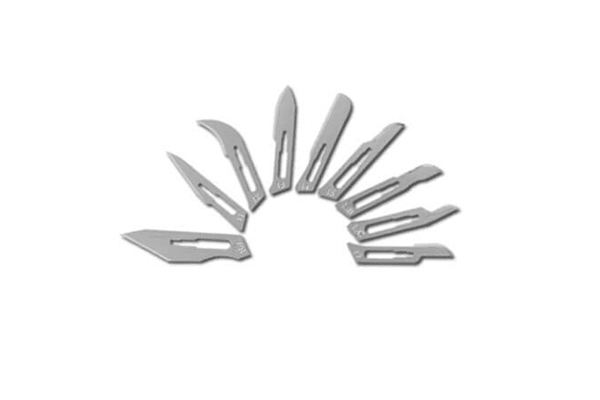In the high-stakes environment of the chanm opere, every tool matters. But few are as critical as the bistèl. An extension of the surgeon’s hand, the Dwa lam chirijikal can be the difference between a clean, quick-healing ensizyon and one that causes unnecessary tissue trauma. For a hospital procurement manager like Mark Thompson, tasked with stocking a surgical center, the array of numbers, shapes, and materials can be daunting. What is the real difference between a #10 and a #15 lam? When is asye kabòn a better choice than asye pur? As Allen, a manufacturer of disposable medical consumables in China, I’ve spent years overseeing the production of these essential tools. Sa Gid pou gwosè lam chirijikal will demystify the world of the Lam chirijikal, helping you make informed decisions that asire your surgeons have the precision instruments they need to achieve the best patient outcomes.
What is a Surgical Blade and Why is Precision So Critical?
A Lam chirijikal, oswa Lam bistouri, is a small, trè byen file cutting instrument used for surgery, anatomical dissection, and various other medical procedures. Unlike a standard knife, a Lam chirijikal is designed for a single purpose: to make clean, precise cuts with minimal damage to surrounding tissues. Sa precision is not just about aesthetics; it is fundamental to the healing process. A clean ensizyon made with a sharp bistèl heals faster, has a lower risk of infection, and results in less scarring.
Sa yo blades come in various shapes and sizes, each engineered for a specific surgical task. Whether a surgeon is making a large incision nan abdominal surgery or a delicate cut in plastic surgery, using the appropriate surgical blade is crucial. The goal is to cut tissue cleanly without crushing or tearing cells, which can trigger a greater inflammatory response and prolong recovery. This is why the quality, prèv, and design of every Lam chirijikal are of the utmost importance.
Decoding the Numbers: What Do Surgical Blade Sizes Really Mean?
The numbering system for lam chirijikal can seem counterintuitive at first, but it provides a standardized way for surgeons to identify the exact gwosè lam ak fòm they need. The system generally categorizes lam based on the handle they fit and their intended use.
Here’s a basic breakdown:
- Blades #10 through #19: Sa yo lam fit a #3 Scalpel Handle. They are typically smaller and used for more delicate or specialized procedures.
- Blades #20 through #25: Sa yo pi gwo lam fit a #4 Scalpel Handle and are souvan itilize for making larger incisions in general surgery or autopsy.
A nonb nan la Lam bistouri refers to its specific size and shape. For example, a #10 lam and a #15 lam will both fit a #3 handle, but they have very different shapes and are used for different types of cuts. Understanding this system is the first step in choosing the right surgical blade.
An In-Depth Look at the Most Common Types of Surgical Blades
While dozens of kalite lam exist, a few key sizes are staples in virtually every chanm opere. Knowing their characteristics is essential for any medical supply manager.
| Nimewo lam | Deskripsyon | Common Uses |
|---|---|---|
| #10 Blade | A Lam koube with a large cutting edge. It is one of the most common blade shapes. | Used for making large incisions in skin and muscle, such as in general and orthopedic surgery. |
| #11 Blade | A triangular lam with a sharp, pointed tip. Also known as a "stab" lam. | Itilize pou fè precise, short incisions, such as draining an abscess or inserting a chest tube. |
| #15 Blade | A small Lam koube with a smaller cutting edge, resembling a miniature #10 lam. | Typically used for making small incisions, intricate cuts, or in pediatric or plastic surgery. |
| #20 Blade | A larger version of the #10 lam, featuring a prominent curved cutting edge. | Used for larger incisions in procedures like thoracic or abdominal surgery. Fits a #4 handle. |
These four lam cover a vast range of Pwosedi chirijikal needs, from broad, sweeping cuts to the most delicate punctures.

How Do You Choose the Right Blade for a Specific Surgical Incision?
Selecting the right surgical blade depends entirely on the task at hand. The choice is primarily dictated by the type of ensizyon required and the tissue being cut. A surgeon considers several factors to Chwazi Dwa a tool for maximum precision ak sekirite.
- For long, straight incisions: A large, Lam koube tankou la #10 lam ou #20 blade is ideal. The koub nan la lam allows the surgeon to use the belly of the blade to create a smooth, continuous cut with a single motion. This is much more efficient and causes less domaj tisi than making multiple small cuts.
- For short, precise cuts: When intricate work is needed, such as in ophthalmology or dermatology, a #15 blade is often the tool of choice. Its small size allows for greater control and maneuverability.
- For stab incisions: The sharply pointed #11 blade is specifically designed for this purpose. Its triangular shape is perfect for puncturing tissue to drain a fluid collection or to initiate an opening for inserting a tube or drain.
The surgeon’s training and experience are paramount, but having the right tools available is a prerequisite for success. This includes not just the lam, but also related items like sterile sutures with needles to close the ensizyon afterward.
Carbon Steel vs. Stainless Steel: Choosing the Right Blade Material
A material of the blade is a critical factor that influences its performance, particularly its précision ak rezistans. The two most common materials for disposable lam chirijikal se asye kabòn ak asye pur. As a manufacturer, we produce both, as each has distinct advantages.
Lam asye kabòn are renowned for their exceptional initial prèv. The fine grain structure of asye kabòn allows it to be honed to an incredibly fine edge, arguably sharper than asye pur. Surgeons often prefer asye kabòn for procedures where the utmost precision is required for the initial ensizyon. Sepandan, asye kabòn is more brittle and susceptible to rust and korozyon, so its packaging must be robust to protect it from humidity.
Stainless steel surgical blades, on the other hand, are highly resistant to korozyon. This makes them more durable and gives them a longer shelf life. While perhaps a fraction less sharp initially than asye kabòn, -wo kalite lam asye pur maintain their edge well throughout a procedure. Their resistance to rust also means there is no risk of metal particles being left in the ensizyon. The choice often comes down to surgical preference and the specific demands of the Pwosedi chirijikal.

Why is the Scalpel Blade Handle Just as Important?
A Lam bistouri is useless without a handle to hold it. The Lam manch, also known as a Bard-Parker handle, is a reusable instrument that the disposable lam attaches to. Just as lam vini nan divès gwosè, so do handles. The key is compatibility.
- #3 Handles: These are smaller and are designed to hold lam in the #10-#19 series. They are used for more delicate work.
- #4 Handles: These are larger and more robust, designed to hold the larger lam of the #20 series.
It is absolutely essential to match the blade size to the correct handle. Attempting to fit a #15 lam onto a #4 handle will not work and is unsafe. When stocking an chanm opere, it’s crucial to have a sufficient supply of both handle types to accommodate all the different kalite lam you provide. The handle’s weight, balance, and ergonomic grip also contribute to the surgeon’s control and reduce fatigue during long procedures.
How Does the Shape of the Blade Impact a Surgical Procedure?
A fòm lam la is not arbitrary; each koub and point is intentionally designed for a specific surgical function. The blade design dictates how it moves through tissue and the type of cut it produces. A straight blade, for example, is good for push cuts, while a Lam koube is better for slicing.
A koub sou yon #10 lam allows for a long, sweeping ensizyon where the pressure is distributed evenly along the cutting edge. This creates a cleaner cut than a straight edge, which would tend to dig in at the tip. The pointed tip of the #11 blade concentrates all the force at a single point, allowing for easy penetration with minimal effort. This variety in gwosè lam ak fòm gives surgeons a versatile toolkit, allowing them to select the perfect instrument to asire the clean execution of chak chirijikal step, from the initial ensizyon to the final debridement.

From a Manufacturer’s View: How Do We Ensure the Sharpness of the Blade?
As a manufacturer, guaranteeing the quality and prèv of our lam chirijikal is our highest priority. The process is a combination of using superior materials and employing advanced manufacturing techniques. It starts with sourcing high-grade asye kabòn ou asye pur from trusted suppliers.
The critical step is the grinding and honing process. We use automated, computer-controlled machines to create the cutting edge at a precise angle. This process is monitored at every stage to asire consistency. After grinding, each lam undergoes a final finishing process to remove any microscopic burrs, resulting in a perfectly smooth, razor-sharp edge. Rigorous quality control checks, including microscopic inspection and sharpness testing, are performed on samples from every batch. This commitment to quality is how we asire that our blades remain sharp and reliable, which in turn enhances patient safety and supports positive surgical outcomes. These are the details that matter when choosing from various Pwodwi medikal.
Are There Other Materials and Types of Blades Used in Surgery?
Pandan asye kabòn ak asye pur dominate the market for disposable lam, specialty Enstriman chirijikal are sometimes made from other materials. These are typically more expensive and reserved for highly specialized fields.
- Lam seramik: Blades made from ceramic are extremely hard and can hold an edge for a very long time. They are also non-magnetic, which is useful in procedures involving MRI.
- Diamond Blades: Used almost exclusively in ophthalmology, diamond lam are the sharpest cutting tools available, capable of making incredibly precise incisions in the delicate tissues of the eye.
- Reusable Blades: While most modern lam chirijikal are single-use disposables to prevent cross-contamination, some specialized, heavy-duty lam are designed to be Lam ki kapab itilize ankò after thorough sterilization.
For the vast majority of procedures, however, the choice between carbon ak lam asye pur provides the necessary performance and is the most cost-effective solution for a busy hospital or surgical center.
Key Considerations When Choosing the Right Blade Supplier
For a procurement manager, choosing the right surgical blade extends to choosing the right supplier. Your decision impacts not just your budget but also the quality of care your facility provides.
- Kalite ak konfòmite: Ensure the supplier adheres to international quality standards like ISO 13485 and has the appropriate regulatory approvals (e.g., CE marking, FDA clearance) for your market.
- Material Transparency: The supplier should be clear about the grade of asye kabòn ou asye pur used. This directly affects the blade’s pèfòmans.
- Konsistans: A prèv ak bon jan kalite nan la lam must be consistent from one batch to the next. Ask about their quality control processes.
- Entegrite anbalaj: Lam must be packaged securely in easy-to-open, sterile packets that protect them from damage and korozyon.
- Reliable Supply Chain: Your supplier must be able to deliver your orders on time to prevent shortages of these critical Enstriman chirijikal, like blades or aspirasyon konekte tib.
Partnering with an experienced manufacturer who understands these requirements is key to keeping your chanm opere well-stocked with reliable, high-performance lam chirijikal.
Takeaways kle
- The Number Matters: A nonb sou yon Lam chirijikal indicates its specific size and shape. Lam #10-#19 fit a #3 handle, while #20-#25 fit a #4 handle.
- Match the Blade to the Incision: Use large, curved blades (#10, #20) for long incisions and small, specialized lam (#11, #15) for precise or stab incisions.
- Material Choice is Key: Lam asye kabòn offer superior initial prèv, pandan lam asye pur provide excellent durability and korozyon resistance.
- Precision Prevents Trauma: Using the correct blade results in a cleaner cut, which leads to faster healing, less scarring, and a lower risk of infection.
- Quality is Non-Negotiable: A prèv, consistency, and sterility of a Lam chirijikal are critical for patient safety.
- Choose Your Supplier Wisely: Partner with a manufacturer who can provide high-quality, compliant lam chirijikal and demonstrate a reliable and transparent supply chain.
Post time: Oct-29-2025





